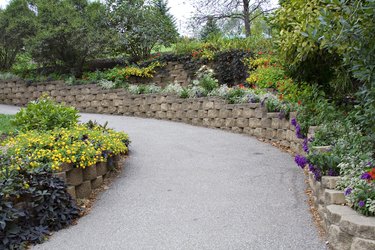
The area you want to place your retaining wall is probably not perfectly level, but in order for the retaining wall to look appealing, it must run straight across the yard. The first step in building a retaining wall is digging a trench. Since the retaining wall blocks rest in this trench, it must be perfectly level. With the proper tools and a fair amount of time, any homeowner can successfully build a retaining wall on uneven ground.
Step 1: Install Stakes and Attach String
Hammer wooden stakes into the ground, one at either end of where the retaining wall will be. Extend a string of twine between the two wooden stakes and tie one end to each stake, pulling the string taut before tying it.
Video of the Day
Step 2: Level the String
Hold a level on the string and move the string either up or down on one of the stakes so it is level. Measure the distance from the string to the ground in various areas to determine where the ground's lowest point is.
Step 3: Dig Retaining Wall Trench
Dig a hole approximately 4 inches more than the retaining wall blocks' thickness and 24 inches wide in the ground's lowest point. Continue to dig the trench, following the string. The trench will remain consistently 24 inches wide; however, the depth will vary slightly. Use the level to check that the bottom of the trench remains level down the entire length.
Step 4: Tamp Soil and Add Gravel
Compact the trench with a tamper. Pour a 4-inch layer of 3/4 minus gravel into the trench. (Three-quarter "minus" gravel means that the gravel should be no larger in diameter than 3/4 inch.) Use a level to ensure the gravel is level and use the tamper to compact it.
Step 5: Add Sand and Wall Blocks
Pour a 1-inch layer of sand over the gravel and compact this as well. Start at one end of the retaining wall and begin placing the retaining wall blocks in the trench. Set a level on each block and check for levelness both front to back as well as left to right. Hit the block with a rubber mallet to lower any high areas into the sand base. Work your way down the trench's length.
Step 6: Add Second Row of Blocks
Set a second row of retaining wall blocks on the first row. Use the level to ensure each block is level. If the first row is level, the second row should automatically be level unless there are inconsistencies in the blocks. Continue to build up your retaining wall to the desired height. Many retaining wall block manufacturers recommend keeping the wall 3 feet tall or less.
Step 7: Pour Gravel and Spread Fabric
Pour crushed gravel behind the retaining wall blocks to increase drainage. Make the gravel's surface level with the bottom of the final retaining wall block row. Cut a strip of landscape fabric to cover the gravel. Pour topsoil over the landscape fabric until it almost reaches the retaining wall's top edge. After several rains, the topsoil layer will sink down a bit, so you'll want to add more topsoil to raise the finished level just below the top edge of the retaining wall.
Video of the Day